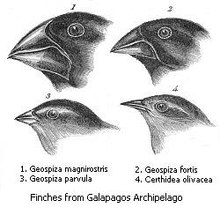Divergent evolution

| Part of a series on |
| Evolutionary biology |
|---|
 |
Divergent evolution or divergent selection is the accumulation of differences between closely related populations within a
, and the evolution of the modern-day dog from the wolf.The term can also be applied in molecular evolution, such as to proteins that derive from homologous genes. Both orthologous genes (resulting from a speciation event) and paralogous genes (resulting from gene duplication) can illustrate divergent evolution. Through gene duplication, it is possible for divergent evolution to occur between two genes within a species. Similarities between species that have diverged are due to their common origin, so such similarities are homologies.[3]
Causes
Animals undergo divergent evolution for a number of reasons linked to changes in environmental or social pressures. This could include changes in the environment, such access to food and shelter.[4] It could also result from changes in predators, such as new adaptations, an increase or decrease in number of active predators, or the introduction of new predators.[5] Divergent evolution can also be a result of mating pressures such as increased competition for mates or selective breeding by humans.[6]
Distinctions
Divergent evolution is a type of evolution and is distinct from convergent evolution and parallel evolution, although it does share similarities with the other types of evolution.[7]
Divergent versus convergent evolution
Convergent evolution is the development of analogous structures that occurs in different species as a result of those two species facing similar environmental pressures and adapting in similar ways. It differs from divergent evolution as the species involved do not descend from a closely related common ancestor and the traits accumulated are similar.[4] An example of convergent evolution is the development of flight in birds, bats, and insects, all of which are not closely related but share analogous structures allowing for flight.[8]
Divergent versus parallel evolution
Parallel evolution is the development of a similar trait in species descending from a common ancestor. It is comparable to divergent evolution in that the species are descend from a common ancestor, but the traits accumulated are similar due to similar environmental pressures while in divergent evolution the traits accumulated are different.[9] An example of parallel evolution is that certain arboreal frog species, 'flying' frogs, in both Old World families and New World families, have developed the ability of gliding flight. They have "enlarged hands and feet, full webbing between all fingers and toes, lateral skin flaps on the arms and legs, and reduced weight per snout-vent length".[10]
Darwin's finches
One of the first recorded examples of divergent evolution is the case of
Divergent evolution in dogs
Another example of divergent evolution is the
Divergent evolution in kittiwakes
Another example of divergent evolution is the behavioral changes in the kittiwake as opposed to other species of gulls. Ancestorial and other modern-day species of gulls exhibit a mobbing behavior in order to protect their young due the nesting at ground-level where they are susceptible to predators.[19] As a result of migration and environmental changes, the kittiwake nest solely on cliff faces. As a result, their young are protected from predatory reptiles, mammals, and birds who struggle with the climb and cliff-face weather conditions, and they do not exhibit this mobbing behavior.[20]
Divergent evolution in cacti
Another example of divergent evolution is the split forming the
See also
References
- ^ "Sympatric speciation". Retrieved 2 February 2016.
- . Retrieved 26 September 2011. (subscription required)
- ISBN 978-1-4832-2734-4, retrieved 2024-03-24
- ^ a b Clark, Mary Ann; Douglas, Matthew; Choi, Jung (2018-03-28). "18.1 Understanding Evolution - Biology 2e | OpenStax". openstax.org. Retrieved 2024-03-24.
- ISSN 1424-2818.
- ^ "Artificial selection". evolution.berkeley.edu. Retrieved 2024-03-24.
- ^ "18.5G: Convergent Evolution". Biology LibreTexts. 2018-07-13. Retrieved 2024-03-24.
- ISBN 978-0-19-999679-7.
- ISSN 0007-0882.
- PMID 28564439.
- ISBN 978-0-7181-3430-3.
- ISBN 978-0-691-04865-9.
- OCLC 82673670.
- PMID 25686609.
- PMID 9987908.
- PMID 20214797.
- ISSN 1543-592X.
- PMID 9180076.
- ^ Alcock, John (2013). Animal Behavior: An Evolutionary Approach, Tenth Edition. pp. 101–109.
- .
- PMID 24611540.
- ^ "Wayback Machine" (PDF). Archived from the original (PDF) on 2012-02-13. Retrieved 2024-03-25.
- PMID 21536881.
Further reading
- Jonathan B. Losos (2017). Improbable Destinies: Fate, Chance, and the Future of Evolution. Riverhead Books. ISBN 978-0399184925.
